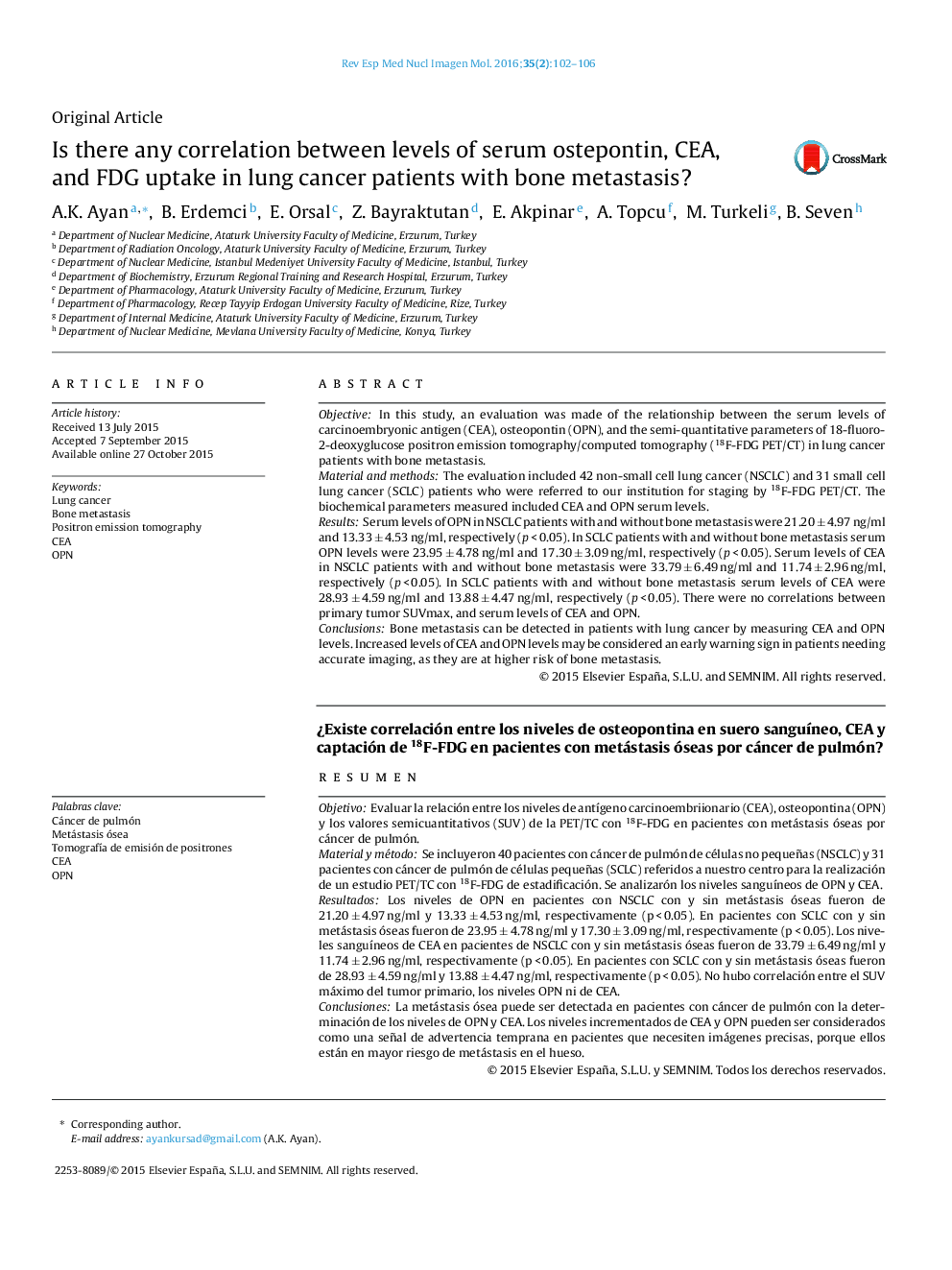| Article ID | Journal | Published Year | Pages | File Type |
|---|---|---|---|---|
| 4250243 | Revista Española de Medicina Nuclear e Imagen Molecular (English Edition) | 2016 | 5 Pages |
ObjectiveIn this study, an evaluation was made of the relationship between the serum levels of carcinoembryonic antigen (CEA), osteopontin (OPN), and the semi-quantitative parameters of 18-fluoro-2-deoxyglucose positron emission tomography/computed tomography (18F-FDG PET/CT) in lung cancer patients with bone metastasis.Material and methodsThe evaluation included 42 non-small cell lung cancer (NSCLC) and 31 small cell lung cancer (SCLC) patients who were referred to our institution for staging by 18F-FDG PET/CT. The biochemical parameters measured included CEA and OPN serum levels.ResultsSerum levels of OPN in NSCLC patients with and without bone metastasis were 21.20 ± 4.97 ng/ml and 13.33 ± 4.53 ng/ml, respectively (p < 0.05). In SCLC patients with and without bone metastasis serum OPN levels were 23.95 ± 4.78 ng/ml and 17.30 ± 3.09 ng/ml, respectively (p < 0.05). Serum levels of CEA in NSCLC patients with and without bone metastasis were 33.79 ± 6.49 ng/ml and 11.74 ± 2.96 ng/ml, respectively (p < 0.05). In SCLC patients with and without bone metastasis serum levels of CEA were 28.93 ± 4.59 ng/ml and 13.88 ± 4.47 ng/ml, respectively (p < 0.05). There were no correlations between primary tumor SUVmax, and serum levels of CEA and OPN.ConclusionsBone metastasis can be detected in patients with lung cancer by measuring CEA and OPN levels. Increased levels of CEA and OPN levels may be considered an early warning sign in patients needing accurate imaging, as they are at higher risk of bone metastasis.
ResumenObjetivoEvaluar la relación entre los niveles de antígeno carcinoembriionario (CEA), osteopontina (OPN) y los valores semicuantitativos (SUV) de la PET/TC con 18F-FDG en pacientes con metástasis óseas por cáncer de pulmón.Material y métodoSe incluyeron 40 pacientes con cáncer de pulmón de células no pequeñas (NSCLC) y 31 pacientes con cáncer de pulmón de células pequeñas (SCLC) referidos a nuestro centro para la realización de un estudio PET/TC con 18F-FDG de estadificación. Se analizarón los niveles sanguíneos de OPN y CEA.ResultadosLos niveles de OPN en pacientes con NSCLC con y sin metástasis óseas fueron de 21.20 ± 4.97 ng/ml y 13.33 ± 4.53 ng/ml, respectivamente (p < 0.05). En pacientes con SCLC con y sin metástasis óseas fueron de 23.95 ± 4.78 ng/ml y 17.30 ± 3.09 ng/ml, respectivamente (p < 0.05). Los niveles sanguíneos de CEA en pacientes de NSCLC con y sin metástasis óseas fueron de 33.79 ± 6.49 ng/ml y 11.74 ± 2.96 ng/ml, respectivamente (p < 0.05). En pacientes con SCLC con y sin metástasis óseas fueron de 28.93 ± 4.59 ng/ml y 13.88 ± 4.47 ng/ml, respectivamente (p < 0.05). No hubo correlación entre el SUV máximo del tumor primario, los niveles OPN ni de CEA.ConclusionesLa metástasis ósea puede ser detectada en pacientes con cáncer de pulmón con la determinación de los niveles de OPN y CEA. Los niveles incrementados de CEA y OPN pueden ser considerados como una señal de advertencia temprana en pacientes que necesiten imágenes precisas, porque ellos están en mayor riesgo de metástasis en el hueso.
